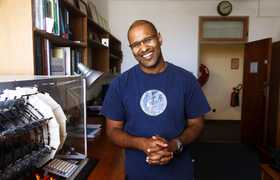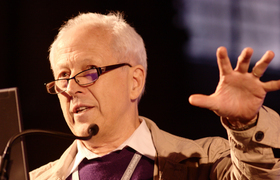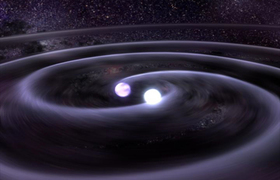‘A great spirit and a wonderful mind’
02 May 2018 | Story Helen Swingler. Video Evan Zerf. Read time 9 min.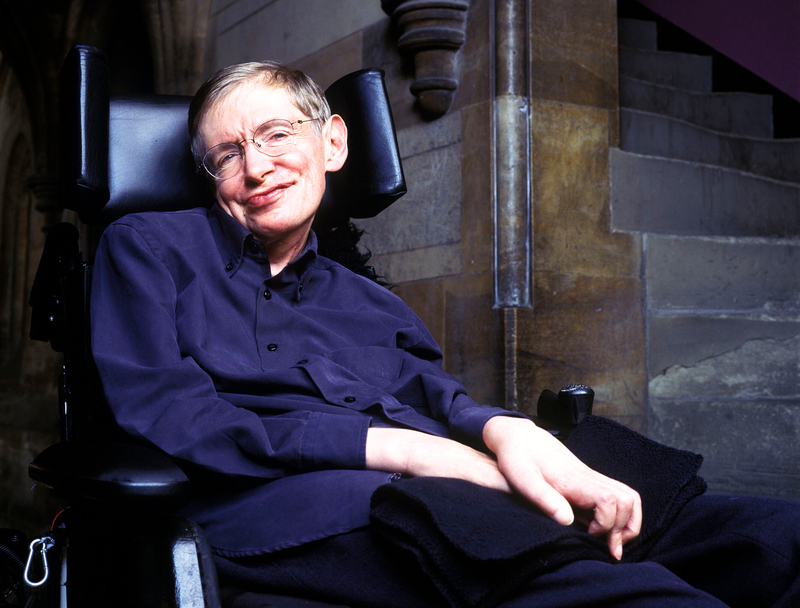
Stephen Hawking was “a great spirit and a wonderful mind”, said senior scholar and Emeritus Distinguished Professor of Complex Systems George Ellis in his recent tribute to the renowned theoretical physicist, a collaborator and friend.
Hawking died on 14 March, aged 76, having been severely debilitated by motor neuron disease for almost all his adult life.
Speaking to a packed lecture theatre in the Department of Physics on 18 April, Ellis recalled how he and Hawking had been research students and then postdocs together in the Department of Applied Mathematics and Theoretical Physics (DAMTP) at Cambridge University with Dennis Sciama as their research supervisor.
It was soon after arriving at Cambridge from Oxford that Hawking, aged 21, began to show signs of the disease that would soon confine him to a wheelchair and later diminish his ability to speak.
Brilliant mind, declining body
But his brilliant mind was not affected by his declining physical abilities.
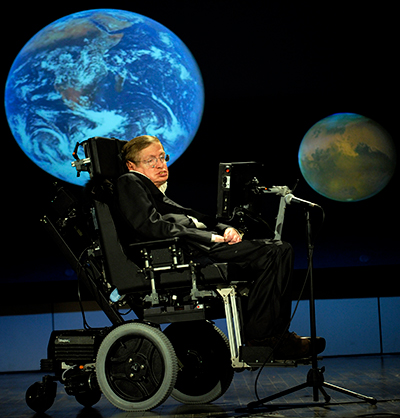
Hawking publicly challenged the legendary Fred Hoyle about the validity of the Hoyle–Narlikar action at a distance theory of gravitation at an “extremely prestigious” Royal Society meeting.
Said Ellis: “Hawking, just a grad student, stood up and said, ‘Professor Hoyle you are wrong.’ Hoyle said, ‘How do you know it’s wrong?’ To which Hawking replied, ‘I have calculated it.’
“This already showed the kind of initiative and the power of Stephen’s thinking, that as a graduate research student he was willing to stand up to one of the most famous research professors in astrophysics at that time.”
Interwoven lives
Hawking married language student Jane Wilde in 1965.
With Sciama’s help and Jane’s support, Hawking completed his PhD and became a Research Fellow, and then a Professorial Fellow. In those days the Hawking and Ellis families visited one another’s homes regularly. They also holidayed together.
Ellis used to push Hawking around in his first (unmotorised) wheelchair and take him to lunch near DAMTP, where they shared an office, Hawking allowing Ellis to cut his food and feed him when he could no longer handle a fork.
Big question
Was there a start to the universe? This is the question they were thinking about at the time, something all the great cosmologists had been looking at since the 1930s, said Ellis.
“After Hawking had publicly challenged Fred Hoyle ... we jointly worked together on proving that there had been a singular start to the universe: a beginning of space and time, as well as of physics.
“We were both postgrads together working to solve this singularity problem (Did the universe have a start?) for a particular class of models. I’d look at him and say, ‘I’ve found a way to prove it,’ and he’d look at me and say, ‘You’ve got it wrong.’ And he would come back to me and say, ‘I’ve found a way to prove it,’ and I’d say, ‘No, you’ve got it wrong.’
“What we had was this mutual interaction, trying ideas, testing them, seeing if they could work and then eventually coming through, and defining ideas which eventually came to something.
“After we jointly published a paper which showed that was indeed the case for a restricted (spatially homogeneous) set of cosmological models, Hawking generalised highly innovative methods introduced by Roger Penrose to show this would remain true for generic inhomogeneous and anisotropic models provided they satisfied some causality and energy conditions, as well as a geometric condition showing gravity was so strong as to cause gravitational lensing by the universe as a whole in the past direction of time.”
They then published a paper showing this geometric condition is indeed satisfied in the real universe because of the existence of cosmic microwave black-body radiation, detected in 1965.
Major publications
Their major graduate text, The Large Scale Structure of Space-Time (Cambridge University Press, 1973) gave a unified presentation of knowledge in the field at that time.
“This has since become a standard reference work in the field,” said Ellis. The book has also appeared in paperback format and has been reprinted many times. “It’s known to graduates as ‘The Yellow Peril’,” he quipped.
In 1988 Hawking’s A Brief History of Time: From the Big Bang to Black Holes was released, described as “one of the greatest popular science books of all time”. It was on the New York Times bestseller list for 147 weeks and a record-breaking 237 weeks on The Times of London bestseller list.
Hawking, he said, had written the book quite consciously because he needed to fund his increasing medical expenses.
“I’m not sure how many people who bought the book understood it! But it succeeded beyond his wildest expectations.”
To make scientific ideas exciting and accessible to children, Hawking also wrote children’s books with his daughter, Lucy Hawking. (UCT’s Xolisa Guzula translated their book, George’s Secret Key to the Universe, into isiXhosa.)
Important contributions
It was after Ellis had returned to UCT as professor and head of Applied Mathematics that Hawking proved his famous result that black holes emit Hawking radiation as a result of quantum field theory effects.
“At first this very important result was disputed by major figures in the field, but it has since become universally accepted. It is his single most important contribution to theoretical physics that has many ramifications and has been widely celebrated.”
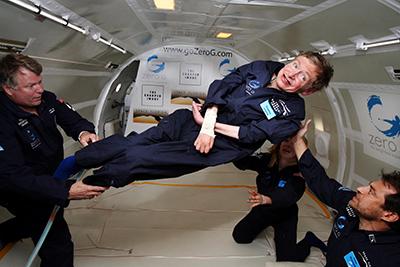
Ellis added, “He did, however, work in many other areas, making important contributions to how seeds for structure formation were created in the very early universe during an ‘inflationary’ epoch, and proposing with Jim Hartle how the universe could have started from a quantum state where time did not exist. The latter proposal is highly innovative but has not received the same recognition and acclaim as his black-hole work.”
But it had become increasingly difficult to communicate with Hawking, despite his computer.
“He initially used a joystick to pick out letters and words on his computer screen. A sentence of five words could take him 10 minutes to assemble.”
Later, even this proved too much.
Hawking enjoyed the fame that came to him: numerous honours and medals and meetings with great personalities, such as Barack Obama and the Pope. He also gave many public presentations using his speech synthesiser, which he required after he had a tracheotomy. He appeared in Star Trek, The Big Bang Theory and The Simpsons.
“But his physical condition had hugely deteriorated,” said Ellis. “When he couldn’t communicate easily or write or turn pages, he did his calculations in his head.”
“When he couldn’t communicate easily or write or turn pages, he did his calculations in his head.”
Courage and humour
He said Hawking had been a beacon of hope for disabled people through his achievements.
“On stage at the London Paralympics, he told the world, ‘Look up at the stars, not at your feet.’ He had huge courage and humour and I think ... really enjoyed adventure. He’d say, ‘So, the sun is going to go out in about 14 billion years and you sit there as if everything is fine’. His birthday parties were celebrated with a disco and fireworks; he enjoyed the good things in life.”
Part of his great resilience was his irrepressible humour. Often, when people gawked at him he’d joke, “Sometimes people mistake me for Stephen Hawking.”
Of his longevity Ellis remarked, “How did Stephen manage to live to the age he did when we all expected him to die before 25? I think it was pure determination, pure will to do what he wanted to do. And I believe that is what kept him alive, and so he was a great spirit and a wonderful mind ... not letting being in that wheelchair prevent him from letting his mind roam through all these possibilities – the future of black holes, the start to the universe, the nature of space-time ...
“He has made a major contribution by what he did and by the way he lived his life. He will be very much missed.”
 This work is licensed under a Creative Commons Attribution-NoDerivatives 4.0 International License.
This work is licensed under a Creative Commons Attribution-NoDerivatives 4.0 International License.
Please view the republishing articles page for more information.







